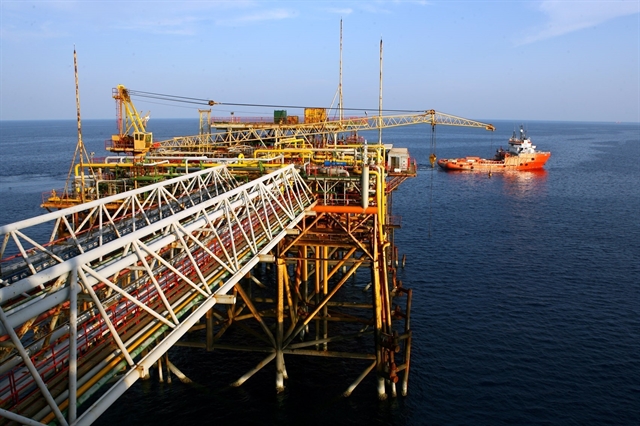 Economy
Economy

 |
| A Petrovietnam rig in Bạch Hổ oil field. Oil and gas extraction is outpacing reserve replenishment. — VNA/VNS Photo Huy Hùng |
HÀ NỘI — Oil and gas extracted more quickly than reserves can be replenished is causing headaches for Petrovietnam, exposing the need for further exploration to identify new supplies to bridge the gap.
Petrovietnam Deputy General Manager Lê Ngọc Sơn estimated that oil and gas exploration added around 12.6 million tonnes annually to the national reserves between 2018 and 2023.
The figure has raised concerns over the productive life of the existing reserves as new oil and gas discoveries were unable to keep pace with the annual extraction of about 22.9 million tonnes.
He said the ratio of reserve growth to extraction growth must surpass 100 per cent to keep oil production sustainable. A ratio of 55 per cent means that extraction has been eating into reserves over the past few years.
According to the census, Việt Nam has discovered 1.5 billion cu.m of oil and gas so far. Of the reserves, around a half has been depleted, whereas the other half comprises one-fourth of oil and three-fourths of gas.
About 30 per cent of the remaining reserves are being tapped by drilling rigs, 30 per cent accumulate in Lô B and Cá Voi Xanh fields, and 40 per cent in other marginal fields.
Oil production saw an annual decline rate of 11 per cent between 2016 and 2020. However, the rate dropped to 6.8 per cent in 2021 and just 1 per cent last year thanks to Petrovietnam's efforts in managemental improvement and technological upgrades.
Meanwhile, many gas reservoirs are drying up quickly. The gas deposit in Lô 06.1 field fell from 2.1 billion cu.m in 2021 to 0.9 billion cu.m in 2023. Lô 06.1 would be put on hold next year if probing is not carried out to discover more gas in the field.
The gas deposit in Lô B and Cá Voi Xanh fields account for 30 per cent of the national gas reserves. However, the absence of a favourable mechanism has delayed the exploitation of the fields, causing a setback for gas output in the short term.
Petrovietnam said it is seeking ways to deal with the output slowdown. One is to find new investment opportunities abroad. However, putting money into oversea projects is not easy given the current legal framework that stymies the energy giant.
The global energy transition has driven financial institutions to tighten their credits to fossil fuel projects. Such a green stance is expected to have a negative impact on oil and gas projects in the next few years.
"Newly-discovered oil and gas fields must be put into operation before 2030 to generate revenues for economic development," added Sơn.
The Petrovietnam leader expected that the entry into force of Petroleum Law on July 1, 2023, would create a favourable legal condition for oil and gas production, removing the obstacles that have been holding back the energy giant for quite a while. — VNS



.jpg)
